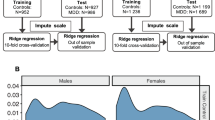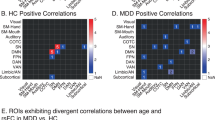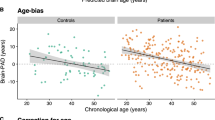Abstract
Neuroticism is one of the main endophenotypes of major depressive disorder (MDD) and is closely related to the negative effect systems of Research Domain Criteria (RDoC) domains. The relationship between neuroticism and aging is dynamic and complex. Moreover, reduced hippocampal volumes are probably the most frequently reported structural neuroimaging finding associated with MDD. However, it remains unclear to what extent hippocampal abnormalities are linked with age and neuroticism changes in people with depression through the adult life span. This study aimed to examine the interplay between aging and neuroticism on hippocampal morphometric across the adult life-span in a relative large sample of patients with depressive disorders (114 patients, 73 females, age range: 18–74 years) and healthy control (HC) subjects (112 healthy controls, 72 females, age range: 19–72 years). MDD patients showed reduced bilateral hippocampal volumes. The effect of aging on the left hippocampal showed linear and the right hippocampal volume non-linear trajectories throughout the adult life span in healthy groups and MDD groups respectively. The hippocampal atrophy was dynamically impacted by depression at the early stages of adult life. Furthermore, we observed that right hippocampal volume reduction was associated with higher neuroticism in depressive patients younger than 30.65 years old. Our results suggest that the age-related atrophy in the right hippocampal volume was more affected by individual differences in neuroticism among younger depressive patients. Hippocampal volume reduction as a vulnerability factor for early-onset and major geriatric depression may have a distinct endophenotype.



Similar content being viewed by others
Data Availability
Data of this research is available from the corresponding author upon reasonable request.
References
Amlien IK, Fjell AM, Tamnes CK, Grydeland H, Krogsrud SK, Chaplin TA, Walhovd KB (2016) Organizing principles of human cortical development-thickness and area from 4 to 30 years: insights from comparative primate neuroanatomy. Cereb Cortex 26(1):257–267. https://doi.org/10.1093/cercor/bhu214
Arnone D, McKie S, Elliott R, Juhasz G, Thomas EJ, Downey D, Anderson IM (2013) State-dependent changes in hippocampal grey matter in depression. Mol Psychiatry 18(12):1265–1272. https://doi.org/10.1038/mp.2012.150
Ballmaier M, Narr KL, Toga AW, Elderkin-Thompson V, Thompson PM, Hamilton L, Kumar A (2008) Hippocampal morphology and distinguishing late-onset from early-onset elderly depression. Am J Psychiatry 165(2):229–237
Barlow DH, Sauer-Zavala S, Carl JR, Bullis JR, Ellard KK (2013) The nature, diagnosis, and treatment of neuroticism. Clin Psychol Sci 2(3):344–365. https://doi.org/10.1177/2167702613505532
Belleau EL, Treadway MT, Pizzagalli DA (2018) The impact of stress and major depressive disorder on hippocampal and medial prefrontal cortex morphology. Biol Psychiatry. 85(6):443–453
Blumberg HP, Kaufman J, Martin A, Whiteman R, Zhang JH, Gore JC, Peterson BS (2003) Amygdala and hippocampal volumes in adolescents and adults with bipolar disorder. Arch Gen Psychiatry 60(12):1201–1208
Bonne O, Brandes D, Gilboa A, Gomori JM, Shenton ME, Pitman RK, Shalev AY (2001) Longitudinal MRI study of hippocampal volume in trauma survivors with PTSD. Am J Psychiatry 158(8):1248–1251
Brodaty H, Luscombe G, Parker G, Wilhelm K, Hickie I, Austin M-P, Mitchell P (2001a) Early and late onset depression in old age: different aetiologies, same phenomenology. J Affect Disord 66(2–3):225–236
Brodaty H, Luscombe G, Parker G, Wilhelm K, Hickie I, Austin M-P, Mitchell P (2001b) Early and late onset depression in old age: different aetiologies, same phenomenology.pdf. J Affect Disord 66:225–236
Cheng W, Rolls ET, Qiu J, Liu W, Tang Y, Huang CC, Feng J (2016) Medial reward and lateral non-reward orbitofrontal cortex circuits change in opposite directions in depression. Brain 139(Pt 12):3296–3309. https://doi.org/10.1093/brain/aww255
Dillon DG, Pizzagalli DA (2018) Mechanisms of memory disruption in depression. Trends Neurosci 41(3):137–149. https://doi.org/10.1016/j.tins.2017.12.006
Docherty AR, Moscati A, Peterson R, Edwards AC, Adkins DE, Bacanu SA, Kendler KS (2016) SNP-based heritability estimates of the personality dimensions and polygenic prediction of both neuroticism and major depression: findings from CONVERGE. Transl Psychiatry 6(10):e926. https://doi.org/10.1038/tp.2016.177
Duman RS, Monteggia LM (2006) A neurotrophic model for stress-related mood disorders. Biol Psychiatry 59(12):1116–1127
Erickson KI, Prakash RS, Voss MW, Chaddock L, Heo S, McLaren M, Woods JA (2010) Brain-derived neurotrophic factor is associated with age-related decline in hippocampal volume. J Neurosci 30(15):5368–5375
Eysenck HJ (1998) Dimensions of personality. Transaction Publishers, New Brunswick, N.J.
Fischl, B., Salat, D. H., Busa, E., Albert, M., Dieterich, M., Haselgrove, C., Dale, A. M. (2002). Whole brain segmentation: automated labeling of neuroanatomical structures in the human brain. Neuron, 33(3), 341–355. Retrieved from http://www.ncbi.nlm.nih.gov/pubmed/11832223
Fiske A, Wetherell JL, Gatz M (2009) Depression in older adults. Annu Rev Clin Psychol 5:363–389
Fjell AM, Walhovd KB, Westlye LT, Østby Y, Tamnes CK, Jernigan TL, Dale AM (2010) When does brain aging accelerate? Dangers of quadratic fits in cross-sectional studies. Neuroimage 50(4):1376–1383
Gatt J, Nemeroff C, Dobson-Stone C, Paul R, Bryant R, Schofield P, Williams L (2009) Interactions between BDNF Val66Met polymorphism and early life stress predict brain and arousal pathways to syndromal depression and anxiety. Mol Psychiatry 14(7):681
Geerlings MI, Gerritsen L (2017) Late-life depression, hippocampal volumes, and hypothalamic-pituitary-adrenal axis regulation: a systematic review and meta-analysis. Biol Psychiatry 82(5):339–350
de Moor MH, van den Berg SM, Verweij KJ, Krueger RF, Luciano M, Boomsma DI, Genetics of Personality Consortium (2015) Meta-analysis of genome-wide association studies for neuroticism, and the polygenic association with major depressive disorder. JAMA Psychiat 72(7):642–650. https://doi.org/10.1001/jamapsychiatry.2015.0554
Gerritsen L, Van Velzen L, Schmaal L, van der Graaf Y, van der Wee N, van Tol M-J, Geerlings M (2015) Childhood maltreatment modifies the relationship of depression with hippocampal volume. Psychol Med 45(16):3517–3526
Goldstein BL, Klein DN (2014) A review of selected candidate endophenotypes for depression. Clin Psychol Rev 34(5):417–427. https://doi.org/10.1016/j.cpr.2014.06.003
Hanson JL, Nacewicz BM, Sutterer MJ, Cayo AA, Schaefer SM, Rudolph KD, Davidson RJ (2015) Behavioral problems after early life stress: contributions of the hippocampus and amygdala. Biol Psychiatry 77(4):314–323. https://doi.org/10.1016/j.biopsych.2014.04.020
Jorm AF (2000) Does old age reduce the risk of anxiety and depression? A review of epidemiological studies across the adult life span. Psychol Med 30:11–22
Kempton MJ, Salvador Z, Munafo MR, Geddes JR, Simmons A, Frangou S, Williams SC (2011) Structural neuroimaging studies in major depressive disorder. Meta-analysis and comparison with bipolar disorder. Arch Gen Psychiatry 68(7):675–690. https://doi.org/10.1001/archgenpsychiatry.2011.60
Korten NC, Comijs HC, Lamers F, Penninx BW (2012) Early and late onset depression in young and middle aged adults: differential symptomatology, characteristics and risk factors? J Affect Disord 138(3):259–267
Kotov R, Krueger RF, Watson D, Achenbach TM, Althoff RR, Bagby RM, Zimmerman M (2017) The hierarchical taxonomy of psychopathology (HiTOP): a dimensional alternative to traditional nosologies. J Abnorm Psychol 126(4):454–477. https://doi.org/10.1037/abn0000258
Lehto K, Mäestu J, Kiive E, Veidebaum T, Harro J (2016) BDNF Val66Met genotype and neuroticism predict life stress: a longitudinal study from childhood to adulthood. Eur Neuropsychopharmacol 26(3):562–569
Lengel GJ, Helle AC, DeShong HL, Meyer NA, Mullins-Sweatt SN (2016) Translational applications of personality science for the conceptualization and treatment of psychopathology. Clin Psychol Sci Pract 23(3):288–308. https://doi.org/10.1111/cpsp.12166
Levinson DJ (1986) A conception of adult development. Am Psychol 41(1):3
Luciano M, Hagenaars SP, Davies G, Hill WD, Clarke TK, Shirali M, Deary IJ (2018) Association analysis in over 329,000 individuals identifies 116 independent variants influencing neuroticism. Nat Genet 50(1):6–11. https://doi.org/10.1038/s41588-017-0013-8
MacMaster FP, Mirza Y, Szeszko PR, Kmiecik LE, Easter PC, Taormina SP, Rosenberg DR (2008) Amygdala and hippocampal volumes in familial early onset major depressive disorder. Biol Psychiatry 63(4):385–390
MacQueen G, Frodl T (2011) The hippocampus in major depression: evidence for the convergence of the bench and bedside in psychiatric research? Mol Psychiatry 16(3):252–264. https://doi.org/10.1038/mp.2010.80
Marizzoni M, Antelmi L, Bosch B, Bartres-Faz D, Muller BW, Wiltfang J, PharmaCog C (2015) Longitudinal reproducibility of automatically segmented hippocampal subfields: a multisite European 3T study on healthy elderly. Hum Brain Mapp 36(9):3516–3527. https://doi.org/10.1002/hbm.22859
McEwen BS (1999) Stress and hippocampal plasticity. Annu Rev Neurosci 22(1):105–122
Mulder RT (2002) Personality pathology and treatment outcome in major depression: a review. Am J Psychiatry 159(3):359–371
Okbay A, Baselmans BM, De Neve JE, Turley P, Nivard MG, Fontana MA, Cesarini D (2016) Genetic variants associated with subjective well-being, depressive symptoms, and neuroticism identified through genome-wide analyses. Nat Genet 48(6):624–633. https://doi.org/10.1038/ng.3552
Otte C, Gold SM, Penninx BW, Pariante CM, Etkin A, Fava M, Schatzberg AF (2016a) Major depressive disorder. Nat Rev Dis Primers 2:16065. https://doi.org/10.1038/nrdp.2016.65
Riem MM, Alink LR, Out D, Van Ijzendoorn MH, Bakermans-Kranenburg MJ (2015) Beating the brain about abuse: empirical and meta-analytic studies of the association between maltreatment and hippocampal volume across childhood and adolescence. Dev Psychopathol 27(2):507–520. https://doi.org/10.1017/S0954579415000127
Roberts BW, Mroczek D (2008) Personality trait change in adulthood. Curr Dir Psychol Sci 17(1):31–35
Roberts BW, Walton KE, Viechtbauer W (2006a) Patterns of mean-level change in personality traits across the life course: a meta-analysis of longitudinal studies. Psychol Bull 132(1):1
Roberts BW, Luo J, Briley DA, Chow PI, Su R, Hill PL (2017) A systematic review of personality trait change through intervention. Psychol Bull 143(2):117
Saleh A, Potter GG, McQuoid DR, Boyd B, Turner R, MacFall JR, Taylor WD (2017) Effects of early life stress on depression, cognitive performance and brain morphology. Psychol Med 47(1):171–181
Schmaal L, Veltman DJ, van Erp TG, Sämann P, Frodl T, Jahanshad N, Niessen W (2016a) Subcortical brain alterations in major depressive disorder: findings from the ENIGMA Major depressive disorder working group. Mol Psychiatry 21(6):806
Schmaal L, Veltman DJ, van Erp TG, Samann PG, Frodl T, Jahanshad N, Hibar DP (2016b) Subcortical brain alterations in major depressive disorder: findings from the ENIGMA Major depressive disorder working group. Mol Psychiatry 21(6):806–812. https://doi.org/10.1038/mp.2015.69
Small SA, Schobel SA, Buxton RB, Witter MP, Barnes CA (2011a) A pathophysiological framework of hippocampal dysfunction in ageing and disease. Nat Rev Neurosci 12(10):585–601. https://doi.org/10.1038/nrn3085
Smith MA, Makino S, Kvetnansky R, Post RM (1995) Stress and glucocorticoids affect the expression of brain-derived neurotrophic factor and neurotrophin-3 mRNAs in the hippocampus. J Neurosci 15(3):1768–1777
Smith DJ, Escott-Price V, Davies G, Bailey ME, Colodro-Conde L, Ward J, O’Donovan MC (2016) Genome-wide analysis of over 106 000 individuals identifies 9 neuroticism-associated loci. Mol Psychiatry 21(6):749–757. https://doi.org/10.1038/mp.2016.49
Sneed JR, Kasen S, Cohen P (2007) Early-life risk factors for late-onset depression. Int J Geriatr Psychiatry 22(7):663–667. https://doi.org/10.1002/gps.1727
Somerville LH (2016) Searching for signatures of brain maturity: what are we searching for? Neuron 92(6):1164–1167. https://doi.org/10.1016/j.neuron.2016.10.059
Steffens DC, McQuoid DR, Payne ME, Potter GG (2011) Change in hippocampal volume on magnetic resonance imaging and cognitive decline among older depressed and nondepressed subjects in the neurocognitive outcomes of depression in the elderly study. American Journal of Geriatric Psychiatry 19(1):4–12. https://doi.org/10.1097/JGP.0b013e3181d6c245
Strange BA, Witter MP, Lein ES, Moser EI (2014) Functional organization of the hippocampal longitudinal axis. Nat Rev Neurosci 15(10):655–669. https://doi.org/10.1038/nrn3785
Tamminga CA, Stan AD, Wagner AD (2010) The hippocampal formation in schizophrenia. Am J Psychiatry 167(10):1178–1193
Thapar A, Collishaw S, Pine DS, Thapar AK (2012) Depression in adolescence. The Lancet 379(9820):1056–1067
Treadway MT, Waskom ML, Dillon DG, Holmes AJ, Park MTM, Chakravarty MM, Fava M (2015a) Illness progression, recent stress, and morphometry of hippocampal subfields and medial prefrontal cortex in major depression. Biol Psychiatry 77(3):285–294
Treadway MT, Waskom ML, Dillon DG, Holmes AJ, Park MTM, Chakravarty MM, Pizzagalli DA (2015b) Illness progression, recent stress, and morphometry of hippocampal subfields and medial prefrontal cortex in major depression. Biol Psychiatry 77(3):285–294. https://doi.org/10.1016/j.biopsych.2014.06.018
Van den Berg MD, Oldehinkel AJ, Bouhuys AL, Brilman EI, Beekman ATF, Ormel J (2001) Depression in later life: three etiologically different subgroups. J Affect Disord 65(1):19–26. https://doi.org/10.1016/s0165-0327(00)00263-9
Van Leemput K, Bakkour A, Benner T, Wiggins G, Wald LL, Augustinack J, Fischl B (2009) Automated segmentation of hippocampal subfields from ultra-high resolution in vivo MRI. Hippocampus 19(6):549–557. https://doi.org/10.1002/hipo.20615
Videbech P, Ravnkilde B (2004) Hippocampal volume and depression: a meta-analysis of MRI studies. Am J Psychiatry 161(11):1957–1966
Vinkers CH, Joëls M, Milaneschi Y, Kahn RS, Penninx BW, Boks MP (2014) Stress exposure across the life span cumulatively increases depression risk and is moderated by neuroticism. Depress Anxiety 31(9):737–745
Vythilingam M, Heim C, Newport J, Miller AH, Anderson E, Bronen R, Charney DS (2002) Childhood trauma associated with smaller hippocampal volume in women with major depression. Am J Psychiatry 159(12):2072–2080
Watson D, Ellickson-Larew S, Stanton K, Levin-Aspenson H (2016) Personality provides a general structural framework for psychopathology: commentary on “translational applications of personality science for the conceptualization and treatment of psychopathology.” Clin Psychol Sci Pract 23(3):309–313. https://doi.org/10.1111/cpsp.12164
Webb CA, Dillon DG, Pechtel P, Goer FK, Murray L, Huys QJ, Pizzagalli DA (2016) Neural correlates of three promising endophenotypes of depression: evidence from the EMBARC study. Neuropsychopharmacology 41(2):454–463. https://doi.org/10.1038/npp.2015.165
Webb CA, Trivedi MH, Cohen ZD, Dillon DG, Fournier JC, Goer F, Pizzagalli DA (2018) Personalized prediction of antidepressant v. placebo response: evidence from the EMBARC study. Psychol Med. https://doi.org/10.1017/S0033291718001708
Wood SN (2004) Stable and efficient multiple smoothing parameter estimation for generalized additive models. J Am Stat Assoc 99(467):673–686
Wood SN (2006) Generalized additive models: an introduction with R. Chapman and Hall/CRC, Florida
Wood SN (2017) Generalized additive models: an introduction with R, 2nd edn. Chapman and Hall/CRC, Florida
Acknowledgements
This research was supported by the National Natural Science Foundation of China (31771231, 32071070), Natural Science Foundation of Chongqing (cstc2019jcyj-msxmX0520, cstc2020jcjy-msxmX0299), the planned project of Chongqing humanities and Social Science (2018PY80, 2019PY51), and Fundamental Research Funds for the Central Universities (SWU119007), Chang Jiang Scholars Program, National Outstanding Young People Plan, Chongqing Talent Program.
Author information
Authors and Affiliations
Corresponding authors
Ethics declarations
Conflict of interest
All authors declare no competing interests.
Additional information
Handling Editor: Armida Mucci.
Publisher's Note
Springer Nature remains neutral with regard to jurisdictional claims in published maps and institutional affiliations.
Supplementary Information
Below is the link to the electronic supplementary material.
Rights and permissions
About this article
Cite this article
Liu, Y., Meng, J., Wang, K. et al. Morphometry of the Hippocampus Across the Adult Life-Span in Patients with Depressive Disorders: Association with Neuroticism. Brain Topogr 34, 587–597 (2021). https://doi.org/10.1007/s10548-021-00846-0
Received:
Accepted:
Published:
Issue Date:
DOI: https://doi.org/10.1007/s10548-021-00846-0




